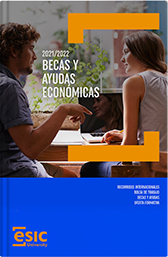Quality standards
State and regional legislation and ESIC University regulations.
Internal quality assurance system
Quality Policy
Today's students are tomorrow's professionals, which is why at ESIC University we want to offer them a differentiated academic offer that provides them with excellent training whenever they need it.
At ESIC University we want to do things better every day and exceed our own limits, which is why we seek constant improvement. For this reason we have launched a Continuous Improvement Project, whose main purpose is to determine the processes and resources necessary to establish a Quality Policy towards Excellence.
The objectives of ESIC University's Quality Policy are:
- To consolidate adequate levels of quality that make those who participate in our programs, people who can develop a personal and professional life at the best level.
- To promote from ESIC University the Quality Models as a driving and innovative axis in the rest of the Organizations, both educational and from other sectors.
- Compliance with the requirements and continuous improvement of the effectiveness of the Quality System (including legal and regulatory).
- To develop a sustainable Quality Model that promotes the five Cultures of ESIC University (Diversity, Excellence, Service, Co-responsibility and Innovation).
D. Eduardo Gómez Martín
President of ESIC University
Quality Manual
OBJECT

ESIC University has its own Quality Management System (SGC-ESIC University), which is included in our quality manual.
This system determines the use and operation of its bodies, regulations, criteria, processes, etc. to improve the quality of our educational offer, our teachers and our students' learning. It also establishes the involvement of the different stakeholders in training activities.
SCOPE
This manual applies to the Degrees and the different Services of ESIC University:
- Grades
- Proprietary Title
- University Master's Degrees
- General Services
This manual contains the policy, values and philosophy on quality shared by the people who are part of ESIC University. Policy and objectives established by the management, which is committed to comply with them.
The manual also includes the organization and general lines of action to be followed in carrying out the different tasks and activities, as well as the procedures detailing the way in which these tasks are performed.
ESIC University staff must know and apply this systematic approach to work performance, as well as the responsibilities associated with the different activities in order to maintain the quality of the services provided and the efficient functioning of the organization.
The quality manual and the information contained therein may not be transferred or reproduced in whole or in part without the express authorization of ESIC University.
PROCESS MAP
The design of ESIC University's Quality Management System (SGC ESIC University) is based on the classification of the processes according to whether they are related, transversal or support processes:
- Two blocks of relationship/attention with stakeholders, and provision of training services:
- Procedures for relations with stakeholders: students, teachers, companies, parents, schools, etc. (coded with number 2).
- Program design and development procedures (coded as number 3)
- Two cross-cutting blocks covering the entire institution:
- Strategic Procedure (coded with number 1)
- Quality Procedures (coded with number 5)
- A support block for the provision of services, which includes procedures such as: Marketing (publication of degree information); Infrastructures (material resources); Management of teaching and non-teaching staff; Purchases and Suppliers; etc. (coded with number 4).
Quality committee, accreditations and rankings
ESIC's Quality System is supported by Commissions in which the different stakeholders that participate in ESIC are represented. ESIC's Strategic and Academic Commissions are represented throughout the different Quality Commissions, thus allowing the alignment of strategic, academic and quality objectives.
ESIC's Internal Quality Assurance System is supported by Commissions in which the different interest groups that participate in ESIC are represented. ESIC's Strategic and Academic Commissions are represented throughout the different Quality, Accreditation and Rankings Commissions, allowing the alignment of strategic, academic and quality objectives.
ESIC's Quality, Accreditation and Rankings Committee
| ESIC University | ESIC Business & Marketing School |
|---|---|
| General Secretary | General Management |
| Rector | Corporate Education Management |
| Vice Chancellor of Quality | Dean |
| Quality Management | International Dean |
| Quality Management | |
| Corporate Education Operations Management | |
| Quality Management | |
| National Territorial Network Directorate | |
| Directorate General of the School of Higher Vocational Training | |
| Academic Direction of the School of Higher Vocational Training | |
| Rankings Management | |
| Business Intelligence Management |
Quality in teaching
Faculty evaluation is one of the key processes in the quality of teaching offered by an educational institution. ESIC, in its culture of continuous improvement, has developed since its inception a faculty evaluation process based on satisfaction surveys of the teaching activity together with the assessments of the Academic Management itself.
This process has been and continues to be one of the pillars of the levels of quality in education set out in ESIC's Mission and Values.
With the arrival of the new regulation of the European Educational Framework, ESIC has given even greater impetus to the teaching activity evaluation processes.
The teaching evaluation designed under the Reference Framework of the Docentia Model provides an even more detailed and regulated model that will give greater solidity over time, both in terms of maintaining the desired levels of quality in the teaching activity of the degrees, as well as in the professional development of teachers within their activity at the Institution.
The ESIC Teaching Evaluation Model is carried out annually.
See ESIC teaching activity evaluation modelView frequently asked questions about ESIC's evaluation model
Teacher's Self-Report on Teaching Activity Form
Department or Program Director's Evaluation Report Form for a faculty member's teaching activity
Documentation on ESIC's Teaching Evaluation under the Docentia Model
| 2023 | |
|---|---|
| Docentia Call Letter from Mr. Ramón Arilla Llorente, ESIC University Rector | Download PDF |
| Regulations (Commissions and Program) of the Docentia Call for Proposals | Download PDF |
| 2016 | |
|---|---|
| Docentia Call Letter from Mr. Rafael Ortega, Dean of ESIC | Download PDF |
| Regulations (Commissions and Program) of the Docentia Call for Proposals | Download PDF |
| 2015 | |
|---|---|
| Docentia Call Letter from Mr. Rafael Ortega, Dean of ESIC | Download PDF |
| External Evaluation Report on the Implementation of the Teaching Activity Evaluation Design for ESIC (2nd follow-up) ANECA | Download PDF |
| Final Report of the Call for Faculty Evaluation under Docentia | Download PDF |
| Regulations (Commissions and Program) of the Docentia Call for Proposals | Download PDF |
| Presentation Summary of Results of the Call for Faculty Evaluation under Docentia | Download PDF |
| 2014 | |
|---|---|
| Docentia Call Letter from Mr. Rafael Ortega, Dean of ESIC | Download PDF |
| External Evaluation Report on the Implementation of the Teaching Activity Evaluation Design for ESIC (1st follow-up) ANECA | Download PDF |
| Final Report of the Call for Faculty Evaluation under Docentia | Download PDF |
| Regulations (Commissions and Program) of the Docentia Call for Proposals | Download PDF |
| Presentation Summary of Results of the Call for Faculty Evaluation under Docentia | Download PDF |
Quality in degrees
ESIC University has a Quality System supported by Commissions and Technical Units in which the different interest groups of ESIC University are represented. ESIC University's Strategic and Academic Commissions are present in all the Quality Commissions, which facilitates the unification of strategic, academic and quality objectives.
We indicate the Quality Commissions and Technical Units according to categories:
Institutional Committees
The Institutional Commissions are formed by the ESIC University Quality Committee and the Quality, Accreditations and other Recognitions Unit.
Quality, Accreditation and Rankings Committee of ESIC University:
Executive Management of ESIC University, Rector ESIC University, Marketing Management, International Development Management, Deputy Director General Secretariat, Big Data & Analytics, Accreditations and Rankings Management, Associate Director of ESIC Rankings and Quality Management and General Secretariat.
Objective of the Committee: To ensure the dissemination and implementation of ESIC University's Quality Policy and the review of the Quality Management System, Accreditations and Rankings.
Frequency: at least three per year, and extraordinary ones as required.
If you wish to contact the Quality Committee of ESIC University, you can do so through the e-mail account calidad@esic.university.
Degree Commissions
For the structure and purpose of the Qualifying Committees, see:
- Committee Degree in Business Administration and Management
- Marketing Commission
- Committee Degree in Advertising and Public Relations
- Degree in Business Administration and Management in the Digital Environment
- Official Master's Degree in People Management and Organizational Development
- Official Master's Degree in Communication and New Technologies Management
- Official Master's Degree in Marketing Management
Institutional quality
ESIC's Internal Quality Assurance System periodically measures, analyzes and reviews institutional and degree indicators in order to establish improvement action plans.

Suggestion box
The suggestion box is intended to provide a means of communication open without interruption, where to express opinions, initiatives, proposals for improvement, or any aspect related to ESIC University.